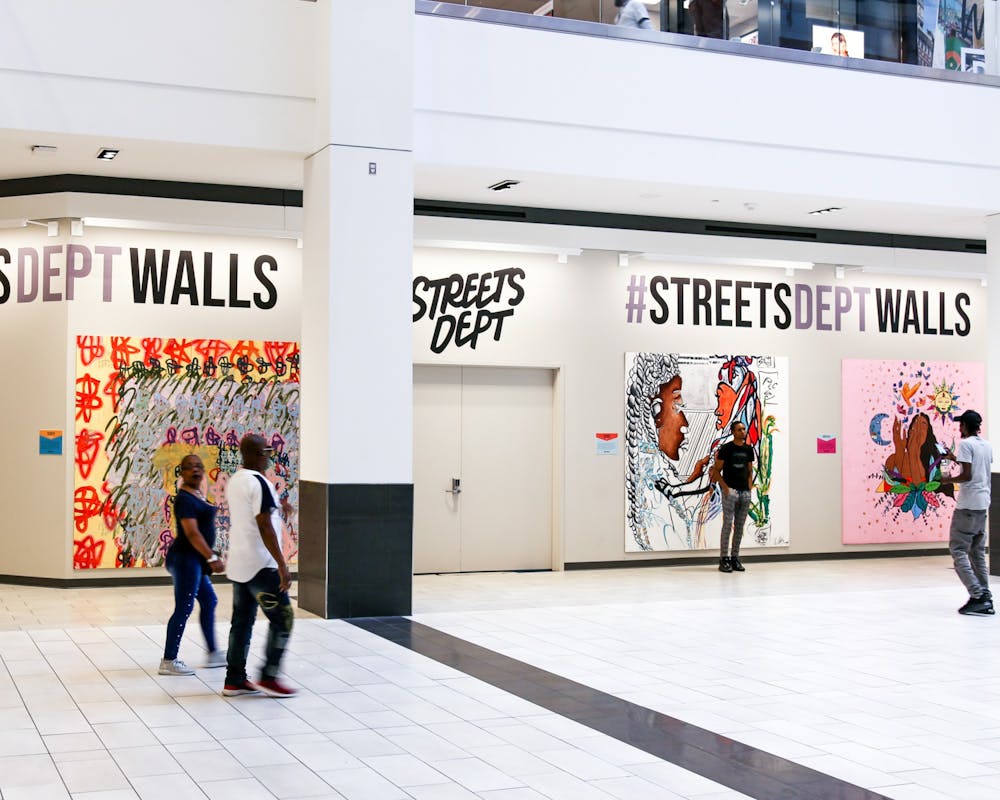Ten artists sit in a line facing an attentive audience at Fashion District Philadelphia. They're here to discuss their artwork. One wears deep blue statement earrings, and another, cat–eye glasses—they all laugh over the holiday music playing in the background. Each of the artists is a contributor to the Streets Dept Walls, a collection of murals on temporary display on the Concourse Level of the Fashion District in Center City, which opened to the public on Nov. 18.
The 10 murals are intended to celebrate the Philly and the artists that make the city the “arts capital of the US,” according to project curator Conrad Benner. They occupy wall space near 11th Street and 9th Street in the District. The murals’ time at the Fashion District has been extended through January, so there's ample time to see the exhibit for yourself
Benner is the founder and editor of Streets Department, a blog based in Philly that works to highlight local artistic talent and street art, in addition to creating exhibitions like the one currently on display at Fashion District. Benner says that “the idea of a temporary or rotating pop–up mural exhibition has been on my bucket list for years now.” So when given the opportunity to do so, he leaped at the chance.

Benner is passionate about art’s role in the public space—he thinks this space should be used for “Philadelphians first.” He describes his motivation behind curating this collection specifically—“These are our walls, these are our artists, let’s use these walls to sort of celebrate this really important, awesome part of local culture.”
The evening of Nov. 18 was the “Artist Talk,” a night of conversation with the featured local artists. They explained their work, the circumstances in which they make their art, and how their art represents them. Manuela Guillén spoke about her painting, Set Them Free, Let Them Be with its gentle pinks and beautiful birds and butterflies. “My parents came from Cuba and from El Salvador…I wanted to make a piece that shows that migration is natural.” The free–flying birds and butterflies represent this movement—they’re based in part on the style of Salvadoran folk art. The surrounding artists nodded as Guillén told of the hope that she wishes to bring to the Latinx community in Philadelphia through her painting.

Crocheter Nicole Nikolich explained the contemplative nature of crocheting for her. “I’ve been able to find a way to meditate and a way to deal with my depression and anxiety.” Her piece, I Change, depicts Nikolich’s experience with seasonal depression—the center of the piece says, “I change with the seasons.” Nikolich said that one of her goals with this publicly displayed piece is to “make crocheting cooler and more modern.” The epigram in the center of the piece is surrounded by crocheted feathers, and since the piece is in a very interactive space, Nikolich said that people often touch them. ”I’ve never done a piece that’s touched so much that I’ve actually had to come and do touch–ups on it.”

A’Driane Nieves’s abstract piece characterizes the way in which the extrinsic world influences our internal life. The painting’s colorful and abstract nature is significant to Nieves. She draws a comparison between bodily systems and the way in which abstract art helps her to analyze her experiences. “If figurative, portrait, and other representative visual works are the organs, muscles, and bones…then abstract is the marrow, the synovial fluid, the neural pathways, the central nervous system, the vitreous body through which we view and process experience.” The surrounding artists hummed and nodded in approval as she shed light on the vulnerability and intimacy of abstraction.
This deliberate approach to making art is common to all the pieces on display. Other murals declare “YOU DESERVE IT!” in neon, depict a self–portrait, or display work from an artist inspired by the faded graffiti on the streets of Philly. All of the murals are personal works of art in a very public space. They allow for reflection in a place that would otherwise be filled with advertisements.

“All of the artists sort of came together, and it’s this cacophony of really great, thoughtful things in a public space,” Benner explains. “We’re celebrating Philly artists, so we want the murals to feel different from each other. We don’t want them to feel like necessarily they’re in the same bucket, because they’re not.” He hopes that the murals serve as a catalyst for thoughtful observation and an acknowledgment of artists in the city. As he asked each artist questions about their work at the Artist Talk, his care and admiration for their work was clear.
Art can be a tool for social change, expression, and a multitude of other things. The art that’s on display in the Streets Dept Walls exhibit certainly has the potential to inspire appreciation for the Philadelphia community. Just as Benner says, “Art can connect us to ourselves, our communities, and our world in ways that few [other things] can. And art in the public space is a tool that’s well used when it reflects our humanity in all its beauty and complexity.”







